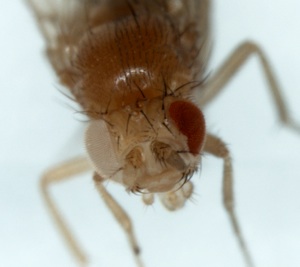A most unusual fly

Lessons in genetics
The lab’s tutorial experiment involves crossing females who are mutant for the recessive markers yellow and white (both X-linked genes) to males that are wildtype for yellow and white but mutant for a dominant eye shape marker, Bar. Because sons get their X chromosomes from only their mothers, while daughters get an X from both parents, the normal males are yellow and white, with oval eyes, like this:

While normal females have brown bodies, red eyes, and have Bar shaped eyes, like this:

So what’s so unusual? It’s that the two pictures above are actually of the same fly!
Viewed from the back, you can see that the left eye is red, the right eye is white, and the wings are different lengths and colors.


This difference is striking to see head-on:

So what happened? This fly is a gynandromorph, an individual with both male and female tissues.
Here’s how it happens: an egg containing the mother’s yellow white X chromosome is fertilized by the male’s Bar chromosome. This egg would normally develop into a Bar female, but at the first cell division, the Bar chromosome got lost from one of the two daughter cells. The X/X cell went on to form the fly’s left half, while the X/O cell went on to form the fly’s right half.
Now, sex determination in flies is different from in humans. In humans the Y chromosome leads to the production of masculinizing hormones to determine sex (so an X/O human develops as a female -- this is called Turner Syndrome). Flies, however, do chromosome counting on a cell-by-cell basis. This means an X/O individual develops as a sterile male, and the Y chromosome is only needed for male fertility.
In this fly, the X/X half executes the female development program, while the X/O half executes the male development program. And since the female half has wildtype copies of yellow and white, those cells are wildtype, while the male half is mutant for both.
Interestingly, the split kind of twists at the tip of the abdomen, so the last segment on the back is all male (as indicated by the heavier pigmentation and yellow coloration), while the same segment on the underside (where the genitalia are) was all female. This fly was even able to produce a couple eggs, indicating it has at least one functional ovary inside.

Gynandromorphs are spontaneously produced in wildtype flies quite rarely, around 1 in 5000 flies. This one was quite nice, since the split was almost perfectly bilateral. Thanks to Adrian Segura for spotting this fly.